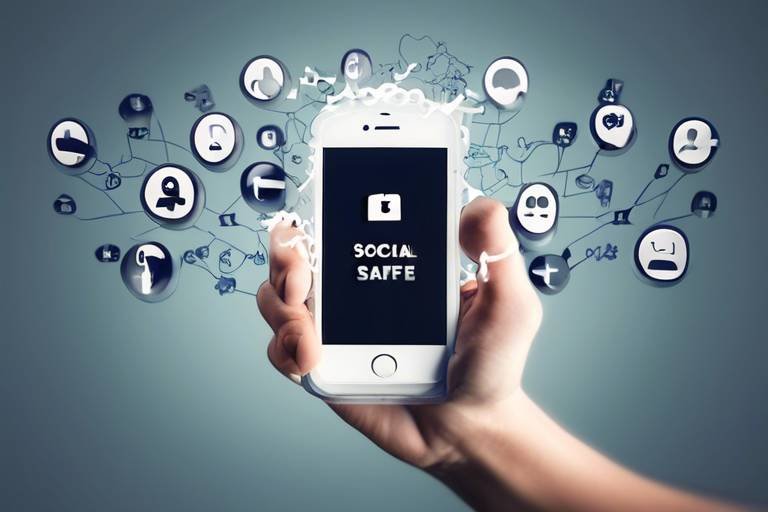Identity Theft and Social Media - A Dangerous Liaison
In today's digital landscape, the intertwining of identity theft and social media presents a growing concern that many users overlook. With the click of a button, we share snippets of our lives, from vacation photos to personal milestones, often without a second thought about who might be watching. This seemingly harmless sharing can lead to devastating consequences, as cybercriminals are lurking in the shadows, ready to exploit our trust and naivety. Have you ever paused to consider how much personal information you reveal online? It's a question worth pondering, especially when the stakes are so high.
Identity theft is not just about stolen credit card numbers or bank accounts; it's about the unauthorized use of someone’s personal information, which can lead to significant financial loss and emotional turmoil. Imagine waking up one day to find that someone has assumed your identity, racked up debts in your name, and tarnished your reputation. The psychological impact can be overwhelming, leaving victims feeling violated and anxious. Understanding how identity theft operates is crucial for anyone navigating the online world, especially on social media platforms where oversharing is the norm.
Social media platforms, while designed to foster connection and community, can inadvertently become a playground for identity thieves. Users often share personal details such as their full names, birthdays, and even their addresses, which can be gold mines for cybercriminals. It's akin to leaving your front door wide open while inviting strangers to come in and take what they want. The more you share, the more vulnerable you become. So, how can we protect ourselves in this digital age? Awareness is the first step, and knowing the tactics used by thieves can empower us to safeguard our personal information.
Cybercriminals employ a variety of tactics to steal identities, and being aware of these methods is crucial for prevention. Common approaches include phishing scams and social engineering techniques. Phishing scams often come in the form of deceptive emails or messages that appear to be from reputable sources, tricking individuals into revealing sensitive information. For example, you might receive an email that looks like it's from your bank, urging you to verify your account details. This is where a keen eye and a healthy dose of skepticism become your best friends.
On the other hand, social engineering is a psychological manipulation tactic that exploits human emotions and trust. Thieves may pose as friends or family members, asking for personal information under the guise of needing help. Recognizing these tactics is essential for maintaining your privacy and protecting your identity. It's not just about having strong passwords; it's about being vigilant and questioning the motives of those who request your personal information.
The consequences of identity theft can be far-reaching and severe. Victims may face damaged credit scores, financial instability, and a tarnished personal reputation. The recovery process can be lengthy and stressful, often requiring extensive documentation and communication with financial institutions. It's a daunting task that no one wants to face, making prevention all the more critical.
To mitigate the risks associated with identity theft, it's vital to take proactive measures. One of the first steps is adjusting your privacy settings on social media platforms. Regularly reviewing these settings can help ensure that only trusted individuals have access to your personal information. Additionally, educating yourself and those around you about the risks of identity theft can foster a community that is better equipped to defend against cyber threats.
In conclusion, the relationship between identity theft and social media is a dangerous one, but it doesn't have to be. By staying informed and vigilant, we can protect our personal information and maintain our privacy in an increasingly interconnected world. Remember, it's not just about what you share, but also about who you share it with. So, the next time you post something online, ask yourself: is this information really necessary? Your identity may depend on it.
- What is identity theft? Identity theft is the unauthorized use of someone’s personal information, often for financial gain.
- How can social media lead to identity theft? Social media encourages users to share personal information, which can be exploited by cybercriminals.
- What are common tactics used by identity thieves? Common tactics include phishing scams and social engineering techniques.
- What can I do to protect myself from identity theft? Adjust your privacy settings, be cautious about what you share, and educate yourself about the risks.
- What are the consequences of identity theft? Consequences can include damaged credit scores, financial loss, and emotional distress.

Understanding Identity Theft
Identity theft is a serious crime that occurs when someone unlawfully uses another person's personal information, such as their name, Social Security number, or financial details, without their consent. This can lead to a cascade of problems for the victim, including significant financial loss, damage to their credit score, and emotional distress. Understanding how identity theft works is essential for developing effective prevention strategies.
At its core, identity theft is about exploitation. Cybercriminals often target individuals who unwittingly expose their personal information through various means, including social media, online shopping, or even public Wi-Fi networks. The mechanisms behind identity theft are not just technical; they also involve psychological manipulation. For instance, many thieves utilize tactics that exploit human emotions, such as fear or urgency, to trick victims into disclosing sensitive information.
There are several common methods that thieves use to steal identities:
- Phishing: This involves sending fraudulent emails or messages that appear to be from reputable sources, tricking individuals into providing personal information.
- Data Breaches: Cybercriminals often hack into databases of companies to steal large amounts of personal data.
- Social Engineering: This technique involves manipulating people into breaking normal security procedures to gain confidential information.
To truly grasp the gravity of identity theft, consider the following statistics:
| Year | Number of Identity Theft Reports | Financial Loss (in billions) |
|---|---|---|
| 2020 | 1.4 million | $56 |
| 2021 | 1.6 million | $52 |
| 2022 | 1.9 million | $43 |
As these numbers reveal, identity theft is not just a minor inconvenience; it is a pervasive issue that affects millions of people every year. The emotional toll can be just as damaging as the financial repercussions, leaving victims feeling violated and vulnerable. Understanding the mechanics of identity theft is the first step in protecting oneself from becoming a victim.

The Role of Social Media
In today's digital landscape, social media has become a double-edged sword. While it connects us with friends, family, and the world at large, it also opens the door to a myriad of risks, particularly when it comes to identity theft. The very platforms designed to foster communication can inadvertently expose users to cybercriminals eager to exploit personal information. Have you ever thought about how much you share online? Every post, photo, and status update can be a potential goldmine for those with malicious intent.
Social media encourages a culture of oversharing, where users often disclose personal details without a second thought. This can include anything from your hometown to your pet's name, and even your birthday. While sharing these tidbits may seem harmless, they can provide thieves with the building blocks they need to steal your identity. For instance, let's consider the information often shared on platforms:
| Type of Information | Potential Risk |
|---|---|
| Full Name | Easy to use for impersonation |
| Birthdate | Can be used to answer security questions |
| Location | Helps in tracking movements and habits |
| Photos of Documents | Direct access to sensitive information |
As you can see, the information we often take for granted can be a treasure trove for identity thieves. They use this data to create a profile of their victims, making it easier to commit fraud. Imagine a thief piecing together your life from your social media posts—your favorite restaurants, your friends, your hobbies. This knowledge can be weaponized against you in ways you might not even anticipate.
Moreover, social media platforms often have a wide audience, meaning that your information isn't just accessible to your friends but potentially to anyone on the internet. This public exposure increases the risk of identity theft exponentially. It's crucial to remember that what you post can linger online indefinitely. Even if you delete a post, it may have already been captured by someone else or indexed by search engines.
So, what can you do to protect yourself? It starts with being mindful of what you share. Here are some practical tips:
- Think Before You Post: Always consider the potential implications of sharing personal information.
- Limit Personal Details: Avoid sharing sensitive information such as your address, phone number, or financial details.
- Adjust Privacy Settings: Regularly review and update your privacy settings to control who can see your information.
- Be Wary of Friend Requests: Only accept requests from people you know personally to reduce the risk of scams.
In conclusion, while social media can be a fantastic tool for connection and expression, it’s essential to approach it with caution. By understanding the risks and taking proactive measures to safeguard your personal information, you can enjoy the benefits of social media without falling prey to identity theft.

Common Tactics Used by Thieves
In the digital age, where our lives are intertwined with social media, identity theft has become an alarming reality. Cybercriminals are constantly devising new and sophisticated tactics to steal personal information, and understanding these methods is essential for safeguarding ourselves. One of the most prevalent tactics employed by thieves is phishing scams. These scams often manifest as seemingly legitimate emails or messages that trick users into revealing sensitive information, such as passwords or credit card numbers. Imagine receiving an email from what appears to be your bank, asking you to verify your account details. If you're not careful, you might just hand over your information without a second thought!
Another common tactic is social engineering, which involves manipulating individuals into divulging confidential information. Thieves often exploit psychological tricks, playing on emotions like fear, urgency, or curiosity. For instance, they might call you pretending to be a tech support representative from a well-known company, claiming there’s a problem with your account that needs immediate attention. In such scenarios, the pressure to act quickly can cloud your judgment, leading to potential exposure of your personal data.
These tactics can take various forms, and it's crucial to recognize them to protect yourself. Here are a few tactics you should be aware of:
- Impersonation: Thieves often impersonate trusted individuals or organizations to gain your trust.
- Urgent Requests: Messages that create a sense of urgency can lead you to act hastily, increasing the likelihood of falling for a scam.
- Fake Websites: Cybercriminals may create websites that look identical to legitimate ones, tricking users into entering their personal information.
By being aware of these tactics, you can develop a more cautious approach to sharing your information online. Always take a moment to scrutinize any request for personal data, and remember: if something feels off, it probably is. Protecting your identity is not just about being vigilant; it’s about being proactive and informed.

Phishing Scams
Phishing scams have become one of the most insidious tactics employed by cybercriminals in the digital age. These scams often masquerade as legitimate emails or messages from trusted sources, luring unsuspecting victims into a false sense of security. Imagine receiving an email that looks like it’s from your bank, complete with their logo and official language, urging you to click a link to verify your account. It’s designed to provoke an immediate reaction, often playing on your fears or urgency. This is the essence of phishing—manipulation through deception.
The primary goal of phishing is to harvest sensitive information such as usernames, passwords, and credit card details. Once a thief has this information, they can wreak havoc on your finances and personal life. The alarming part is that these scams are becoming increasingly sophisticated. Cybercriminals are constantly refining their methods, making it harder for the average person to detect a scam. For instance, they might use personal information gleaned from social media to craft a more convincing message, making it seem as though it is coming from a friend or colleague.
To defend against phishing scams, it’s essential to be vigilant. Here are some common signs that an email or message may be a phishing attempt:
- Generic Greetings: Phishing emails often use generic salutations like "Dear Customer" instead of your name.
- Urgent Language: Messages that create a sense of urgency, such as threats to close your account, are red flags.
- Suspicious Links: Hover over links to see the actual URL. If it looks strange or doesn’t match the supposed sender, don’t click it.
- Spelling and Grammar Errors: Many phishing attempts contain poor spelling and grammatical mistakes.
It's also important to remember that legitimate organizations will never ask for sensitive information through email. If you’re ever in doubt, it’s best to contact the company directly using contact information from their official website. Additionally, consider using two-factor authentication (2FA) wherever possible. This adds an extra layer of security to your accounts, making it much harder for thieves to gain access, even if they do manage to steal your password.
In conclusion, while phishing scams can be alarming, awareness and education are your best defenses. By staying informed about the tactics used by cybercriminals and being cautious with your personal information, you can significantly reduce the risk of falling victim to these scams. Remember, when it comes to your online safety, it’s always better to be safe than sorry!
- What should I do if I think I've been a victim of a phishing scam?
If you believe you've fallen for a phishing scam, immediately change your passwords and monitor your accounts for any unauthorized activity. Report the incident to your bank and consider placing a fraud alert on your credit report. - How can I recognize a phishing email?
Look for generic greetings, urgent language, suspicious links, and spelling errors. If it seems off, it probably is. - Is it safe to click on links in emails from known contacts?
Even if the email appears to be from someone you know, verify by contacting them through another method before clicking any links.

Social Engineering Techniques
Social engineering is a cunning art that preys on human psychology rather than technical vulnerabilities. Imagine a magician who doesn’t just pull rabbits out of hats but instead manipulates the audience into revealing their secrets. That’s what social engineers do—they exploit our natural tendencies to trust, to be helpful, and to seek connection. One common tactic involves impersonating a trusted figure, like a bank representative or a tech support agent, to elicit sensitive information. This can happen over the phone, through emails, or even in person.
These deceptive practices can be incredibly convincing. For instance, a fraudster might call you claiming to be from your bank, saying there’s been suspicious activity on your account. They might ask you to verify your identity by providing your Social Security number or account details. In the heat of the moment, you might think you’re protecting your finances, but in reality, you’re handing over the keys to your identity. It’s crucial to remember that legitimate organizations will never ask for sensitive information in such a manner.
Another common technique involves the creation of fake social media profiles to gain trust. By posing as someone you know or someone who shares mutual connections, they can easily engage you in conversation and coax out personal details. This is where oversharing on social media becomes particularly dangerous. When individuals post about their vacations, family events, or even their pets’ names, they inadvertently provide thieves with a treasure trove of information that can be used to answer security questions or to authenticate accounts.
Recognizing the signs of social engineering can be your first line of defense. Here are some red flags to watch out for:
- Unsolicited communication asking for personal information.
- Pressure tactics, such as urgency or threats.
- Requests for information that seem irrelevant or unnecessary.
By being aware of these tactics, you can better protect yourself from falling victim to identity theft. Always take a moment to verify the identity of anyone asking for sensitive information, especially if it comes unexpectedly. A simple call back to a known number or a visit to the official website can save you from a potential disaster. Remember, in the world of social engineering, a little skepticism can go a long way in safeguarding your personal information.
Q: What is social engineering?
A: Social engineering is a manipulation technique that exploits human psychology to trick individuals into divulging confidential information.
Q: How can I identify social engineering attempts?
A: Look for unsolicited requests for personal information, pressure tactics, and anything that seems out of the ordinary.
Q: What should I do if I suspect I've been targeted by social engineering?
A: If you believe you’ve been targeted, do not provide any information. Report the incident to the appropriate authorities and consider monitoring your financial accounts for unusual activity.

Consequences of Identity Theft
Identity theft is not just a mere inconvenience; it can unleash a storm of repercussions that can significantly alter a victim's life. Imagine waking up one day to find that your hard-earned savings have been drained, your credit score has plummeted, and your reputation has been tarnished—all because someone decided to impersonate you. The consequences can be both financial and emotional, making it essential to understand the full scope of what identity theft can entail.
First and foremost, one of the most immediate impacts is financial loss. Victims often face unauthorized charges on their credit cards or bank accounts, leading to a frustrating battle to reclaim their funds. In many cases, recovering stolen money can take weeks or even months. According to a recent study, the average cost of identity theft per victim can exceed $1,000, not including the time and effort spent resolving the issues. This financial burden can lead to a cascade of additional problems, such as an inability to pay bills, which can further damage one's credit score.
Speaking of credit scores, identity theft can have a long-lasting impact on your financial reputation. A compromised credit report can make it challenging to secure loans, mortgages, or even rental agreements. In fact, some victims report being denied credit for years after their identity has been stolen. This situation can feel like a dark cloud hanging over your financial future, making it difficult to regain stability and trust with financial institutions.
Moreover, the emotional toll cannot be underestimated. Victims often experience feelings of violation, anxiety, and even depression as they navigate the aftermath of identity theft. The sense of security that once enveloped them is shattered, leaving them in a constant state of vigilance. Many individuals find themselves obsessively monitoring their accounts and credit reports, which can lead to increased stress and a diminished quality of life.
In addition to these immediate consequences, there are also potential legal issues to consider. Victims may find themselves embroiled in complex legal battles to clear their names, which can be both time-consuming and costly. The process of disputing fraudulent charges and correcting credit reports often requires extensive documentation, making it a daunting task for many.
To illustrate the range of consequences, here's a brief overview:
| Type of Consequence | Description |
|---|---|
| Financial Loss | Unauthorized charges leading to significant out-of-pocket expenses. |
| Credit Score Damage | Long-term impact on creditworthiness, affecting loans and housing. |
| Emotional Distress | Feelings of anxiety, violation, and stress following the theft. |
| Legal Complications | Potential legal battles to restore identity and rectify financial issues. |
In conclusion, the consequences of identity theft extend far beyond immediate financial loss. They ripple through various aspects of a victim's life, creating a complex web of challenges that can take years to untangle. Understanding these consequences is vital for anyone to appreciate the importance of safeguarding personal information in today's digital landscape.
- What should I do if I suspect my identity has been stolen? Immediately contact your bank and credit card companies, report the theft to the authorities, and consider placing a fraud alert on your credit report.
- How can I protect myself from identity theft? Regularly monitor your financial accounts, use strong passwords, and adjust privacy settings on social media platforms.
- Is identity theft a common crime? Yes, identity theft is increasingly common, with millions of victims reported each year.

Preventative Measures
In today's digital landscape, where our lives are increasingly intertwined with social media, taking proactive steps to safeguard our personal information is more critical than ever. Identity theft can feel like a looming shadow, but by implementing effective preventative measures, we can significantly reduce our vulnerability. It's like locking the doors to your house; you wouldn't leave them wide open for anyone to stroll in, right? Similarly, we must protect our online presence with the same diligence.
One of the most effective ways to enhance your security on social media platforms is by adjusting your privacy settings. Each platform offers a variety of options that allow you to control who sees your posts, who can send you friend requests, and even who can look you up using your email or phone number. Regularly reviewing and updating these settings is crucial. It’s not a one-time thing; think of it as routine maintenance for your online safety.
Additionally, it's essential to be selective about the information you share. Oversharing can be tempting, especially when it comes to sharing life milestones or exciting news. However, consider this: every time you post personal details—like your birthday, vacation plans, or even your pet's name—you might be inadvertently providing a thief with the very information they need to impersonate you. It's like handing over the keys to your house without a second thought.
Educating yourself and those around you about the risks associated with identity theft is another powerful tool in your arsenal. Awareness is your best defense. Share knowledge about common scams and protective measures with friends and family. You can even organize a small workshop or discussion group to talk about cybersecurity. Remember, it's not just about protecting yourself; it's about creating a community that looks out for one another.
To further illustrate the importance of these measures, consider the following table that outlines some common preventative strategies along with their benefits:
| Preventative Measure | Benefit |
|---|---|
| Adjust Privacy Settings | Limits access to your personal information |
| Be Cautious with Sharing | Reduces the risk of oversharing sensitive data |
| Educate Yourself and Others | Increases awareness of identity theft risks |
| Use Strong Passwords | Enhances account security and prevents unauthorized access |
| Enable Two-Factor Authentication | Provides an extra layer of security for your accounts |
Lastly, using strong, unique passwords for each of your accounts is another vital step. Think of your password as the secret code to your treasure chest. If it’s weak or reused across multiple sites, you might as well be leaving the chest wide open for thieves. Consider using a password manager to help you create and store complex passwords without the hassle of remembering each one.
In conclusion, while the digital world presents various challenges, taking these preventative measures can significantly enhance your online security. By actively engaging in protecting your personal information, you can enjoy the benefits of social media without the looming threat of identity theft. So, take a moment to assess your online habits and make the necessary adjustments. Your future self will thank you!
- What is identity theft? - Identity theft is the unauthorized use of someone else's personal information, often leading to financial loss.
- How can I protect my social media accounts? - Adjust your privacy settings, use strong passwords, and be cautious about the information you share.
- What should I do if I become a victim of identity theft? - Report the theft to your bank, credit agencies, and local authorities immediately.
- Is it safe to share personal information on social media? - It can be risky; always think twice before sharing sensitive information publicly.

Privacy Settings on Social Media
When it comes to safeguarding your personal information on social media, privacy settings are your first line of defense. Think of them as the locks on your front door; without them, anyone can just stroll in and take whatever they want. Most social media platforms offer a range of privacy options, but the key is knowing how to use them effectively. It's not just about setting them once and forgetting about it. Regularly reviewing and updating these settings is crucial, especially as platforms frequently update their policies and features.
For instance, let’s take a closer look at some common privacy settings available on popular social media platforms:
| Social Media Platform | Key Privacy Features |
|---|---|
| Profile visibility, friend requests, post visibility, and location sharing. | |
| Private accounts, story sharing settings, and comment controls. | |
| Protected tweets, direct message settings, and follower controls. | |
| Profile visibility, connection requests, and activity broadcasts. |
Now, you might be wondering, "How do I even access these settings?" Well, it’s usually pretty simple. Most platforms have a dedicated settings or privacy section in your account menu. Here, you can customize who sees your posts, who can send you friend requests, and even whether your profile appears in search results. It’s like having a personal security guard for your online presence!
Another important aspect to consider is the information you share in your posts. Even if your privacy settings are tight, oversharing can still lead to vulnerabilities. For example, sharing your location or details about your daily routine can make it easier for cybercriminals to track you. So, always think twice before hitting that post button. Ask yourself, "Would I share this information with a stranger?" If the answer is no, then it’s best to keep it to yourself.
Moreover, it’s essential to educate your friends and family about the importance of privacy settings too. You may have your settings locked down, but if your friends are tagging you in public posts or sharing your information without consent, it can undermine your efforts. Encourage them to be mindful of their privacy settings as well. After all, it's a team effort when it comes to protecting your digital identity!
In conclusion, regularly reviewing and adjusting your privacy settings is not just a good practice; it's a necessity in our increasingly connected world. By taking these proactive steps, you can significantly reduce the risk of identity theft and ensure that your personal information remains just that—personal.
- What are privacy settings? Privacy settings are options provided by social media platforms that allow users to control who can see their information and how it can be shared.
- How often should I update my privacy settings? It’s a good idea to review your privacy settings at least once every few months or whenever a social media platform updates its policies.
- Can I make my account completely private? Yes, most platforms allow you to set your account to private, meaning only approved followers can see your posts and information.
- What should I do if I suspect my account has been compromised? Immediately change your password, review your privacy settings, and consider enabling two-factor authentication for added security.

Educating Yourself and Others
When it comes to identity theft, knowledge is your best defense. Educating yourself about the various tactics used by cybercriminals is crucial in today’s digital landscape. The more you know, the better equipped you are to protect yourself and your loved ones. Start by familiarizing yourself with common scams and the signs that someone might be trying to steal your identity. For example, always be skeptical of unsolicited emails or messages asking for personal information. Remember, if something feels off, it probably is!
But it doesn’t stop with just your own awareness. Sharing this information with friends and family can create a ripple effect of knowledge that strengthens your entire community's defenses. Consider organizing a small gathering or workshop where you can discuss the importance of safeguarding personal information. You can cover topics such as how to set strong passwords, the importance of two-factor authentication, and the dangers of oversharing on social media. By engaging in conversations about these issues, you not only help others but also reinforce your own understanding.
Additionally, utilizing online resources can be incredibly beneficial. Websites dedicated to cybersecurity often provide up-to-date information on the latest threats and preventive measures. You can also follow reputable blogs or subscribe to newsletters that focus on digital safety. These platforms frequently share tips and real-life stories that can enhance your awareness and preparedness.
Furthermore, consider leveraging social media for educational purposes. Create posts that highlight key points about identity theft and encourage your followers to share them. This not only spreads awareness but also sparks discussions that can lead to deeper understanding. You might even create an infographic summarizing essential tips for protecting personal information, making it easy for others to digest and share.
In summary, educating yourself and others about identity theft is not just an individual effort; it’s a community initiative. By spreading knowledge and fostering open discussions, we can build a robust defense against the ever-evolving tactics of cybercriminals. Remember, the more we know, the more we can protect ourselves and those we care about.
- What are some signs that my identity has been stolen? Look out for unfamiliar accounts, unexpected bills, and credit report discrepancies.
- How can I secure my social media accounts? Use strong passwords, enable two-factor authentication, and regularly review your privacy settings.
- What should I do if I suspect identity theft? Report it to your bank, credit card company, and local authorities immediately.
- Can I recover from identity theft? Yes, while it can be a long process, many have successfully regained control of their identity.
Frequently Asked Questions
- What is identity theft?
Identity theft is when someone unlawfully uses your personal information, like your name, Social Security number, or bank details, to commit fraud or other crimes. It's like a thief breaking into your house, but instead, they're stealing your identity online!
- How can social media contribute to identity theft?
Social media can be a double-edged sword. When people overshare personal details, they inadvertently make it easier for cybercriminals to gather the information they need to impersonate them. Think of it as leaving your front door wide open while you’re away—tempting for any intruder!
- What are common tactics used by identity thieves?
Identity thieves often use tactics like phishing scams and social engineering. Phishing involves tricking you into giving up your sensitive information via fake emails or messages, while social engineering manipulates you into revealing personal details. Both are like a magician's tricks—deceptive and designed to mislead!
- How can I protect myself from phishing scams?
To protect yourself from phishing scams, always verify the source of any email or message before clicking on links or providing personal information. If something seems off, trust your instincts! It's better to be safe than sorry.
- What should I do if I become a victim of identity theft?
If you find yourself a victim of identity theft, act quickly! Report it to your bank, credit card companies, and local authorities. The sooner you act, the better your chances of recovering your identity and minimizing damage.
- How can I adjust my privacy settings on social media?
Most social media platforms allow you to customize your privacy settings. Go to your account settings and look for privacy options. Regularly review these settings to control who can see your information—think of it as locking your doors and windows!
- Why is educating myself about identity theft important?
Education is your best defense against identity theft. The more you know about the risks and how to protect yourself, the less likely you are to fall victim. It’s like learning the rules of a game—knowing them helps you play smarter!



















